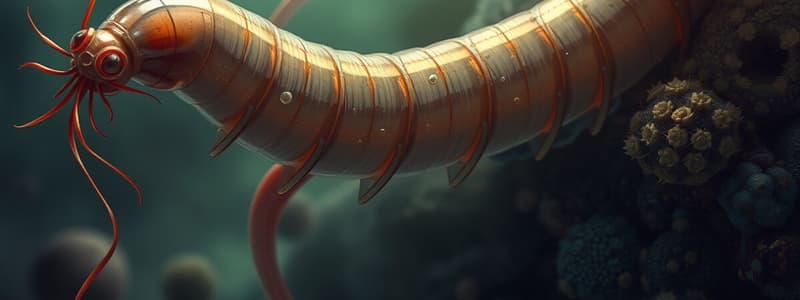Podcast
Questions and Answers
Give a few examples of animals found within the taxon Annelida.
Give a few examples of animals found within the taxon Annelida.
Earthworms, leeches, clamworms
How many species are found within the phylum Annelida?
How many species are found within the phylum Annelida?
15,000
During which time period did the phylum Annelida originate?
During which time period did the phylum Annelida originate?
Pre Cambrian
What is the major contribution of the phylum Annelida in relation to global temperatures?
What is the major contribution of the phylum Annelida in relation to global temperatures?
Briefly characterize the phylum Annelida.
Briefly characterize the phylum Annelida.
What are the 'new' evolutionary features of the phylum Annelida?
What are the 'new' evolutionary features of the phylum Annelida?
What is metamerism, and what is its importance?
What is metamerism, and what is its importance?
What are setae, and why are they important?
What are setae, and why are they important?
Give a brief overview of the classification within the phylum Annelida.
Give a brief overview of the classification within the phylum Annelida.
Characterize the class Oligochaeta.
Characterize the class Oligochaeta.
What is the ecological importance of earthworms?
What is the ecological importance of earthworms?
Explain how earthworms move.
Explain how earthworms move.
What is a typhlosole?
What is a typhlosole?
Give a brief overview of the digestive system in an earthworm.
Give a brief overview of the digestive system in an earthworm.
What is the importance of the circular and longitudinal muscles in earthworms?
What is the importance of the circular and longitudinal muscles in earthworms?
Briefly describe the circulatory system in an earthworm.
Briefly describe the circulatory system in an earthworm.
How does an earthworm exchange gases with its surrounding environment?
How does an earthworm exchange gases with its surrounding environment?
How do earthworms reproduce?
How do earthworms reproduce?
Give a brief overview of the anatomy of the reproductive system in earthworms.
Give a brief overview of the anatomy of the reproductive system in earthworms.
Briefly describe the nervous system of an earthworm.
Briefly describe the nervous system of an earthworm.
Flashcards are hidden until you start studying
Study Notes
Examples of Animals in Annelida
- Earthworms belong to Class Oligochaetes.
- Leeches are classified under Class Hirudinea.
- Clamworms are part of Class Polychaetes.
Species and Origin
- Approximately 15,000 species of annelids exist.
- Annelida originated during the Pre-Cambrian period.
Contribution to Global Temperatures
- Annelids play a crucial role in recycling decomposed carbon.
- They help regulate greenhouse gases, which can affect global temperatures and climate stability.
Characteristics of Annelida
- Bodies are segmented into metameres.
- Other than leeches, members possess setae, chitinous bristles aiding in movement and gas exchange.
New Evolutionary Features
- Introduction of metanephridia for excretion.
- Presence of a coelom (body cavity).
- Segmented body structure allows for increased complexity.
Importance of Metamerism
- Segmentation leads to more organized and complex bodily systems.
- Enhances movement capabilities through localized control.
Setae Explanation
- Setae are hairlike bristles made of chitin.
- Vital for locomotion and facilitating gas exchange.
Classification Overview
- Class Polychaeta includes marine annelids.
- Class Oligochaeta comprises terrestrial and freshwater annelids like earthworms.
- Class Hirudinea consists of leeches found in freshwater and terrestrial environments.
Class Oligochaeta Characteristics
- Contains over 3,000 species.
- Found in terrestrial and aquatic habitats.
- Generally lack pronounced setae.
Ecological Importance of Earthworms
- Aerate soil to improve air and water access for plant roots.
- Decompose organic matter, enriching soil nutrient content.
Earthworm Movement
- Utilizes peristaltic motion for locomotion.
- Anterior circular muscles contract to elongate the body, followed by longitudinal muscles contracting to propel forward.
Digestion in Earthworms
- Equipped with calciferous glands for calcium and pH regulation.
- The typhlosole increases intestinal surface area for enhanced nutrient absorption.
Importance of Muscles
- Circular and longitudinal muscles aid in effective movement throughout each body segment.
Circulatory System Overview
- Distinction between coelomic fluid and blood systems.
- Blood circulates through dorsal vessels and aortic arches, which pump it into the ventral vessel for body-wide distribution.
Gas Exchange
- Earthworms exchange gases primarily through diffusion across their moist skin surfaces.
Reproduction Process
- Earthworms are monoecious, possessing both male and female reproductive organs.
- They engage in copulation, exchange sperm, and create a cocoon for fertilized eggs.
Reproductive Anatomy
- Hermaphroditic structure, characterized by a clitellum that secretes mucus for copulation.
Nervous System Structure
- Comprised of a ganglia and a ventral nerve cord, coordinating movement and responses.
Studying That Suits You
Use AI to generate personalized quizzes and flashcards to suit your learning preferences.




